
Concept explainers
(a)
Interpretation: The organic product that is formed in the given reaction is to be determined.
Concept introduction: The various organic reactions form different organic products with the help of the variety of reagents. Some of the organic compounds are formed by the characteristic action of the various
Answer to Problem 25.65P
The product of the given reaction is,
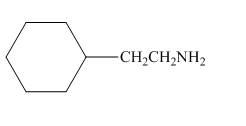
Explanation of Solution
The product formed by the reaction of the given

Figure 1
In the given reaction, nitrogen present in ammonia acts as a nucleophile and attacks at carbon atom which is directly attached with electronegative chlorine atom. Chlorine ion being a good leaving group, leaves the reactant site simultaneously which results in the formation of a desired
The product of the given reaction is shown in Figure 1.
(b)
Interpretation: The organic product that is formed in the given reaction is to be determined.
Concept introduction: The various organic reactions form different organic products with the help of the variety of reagents. Some of the organic compounds are formed by the characteristic action of the various functional groups present in them.
Answer to Problem 25.65P
The product of the given reaction is
Explanation of Solution
The product formed by the reaction of the given reactant with
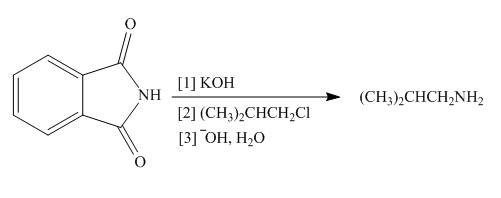
Figure 2
In the given reaction, nitrogen present in the given reaction is firstly reacts with
The product of the given reaction is
(c)
Interpretation: The organic product that is formed in the given reaction is to be determined.
Concept introduction: The various organic reactions form different organic products with the help of the variety of reagents. Some of the organic compounds are formed by the characteristic action of the various functional groups present in them.
Answer to Problem 25.65P
The product of the given reaction is,
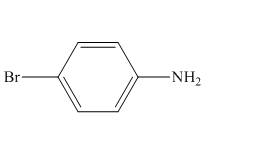
Explanation of Solution
The product formed by the reaction of given nitro compound with tin in the presence of an acid is shown as,

Figure 3
In the given reaction, nitro group of the reactant reacts with
The product of the given reaction is shown in Figure 3.
(d)
Interpretation: The organic product that is formed in the given reaction is to be determined.
Concept introduction: The various organic reactions form different organic products with the help of the variety of reagents. Some of the organic compounds are formed by the characteristic action of the various functional groups present in them.
Answer to Problem 25.65P
The product of the given reaction is,
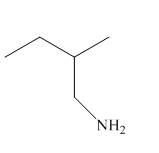
Explanation of Solution
The product formed by the reaction of given cyano compound with

Figure 4
In the given reaction, cyano group of the reactant reacts with lithium aluminum hydride that results in the reduction of cyano group into an amino group in the presence of water. Thus, lithium aluminum hydride being a strong reducing agent forms a desired amine product.
The product of the given reaction is shown in Figure 4.
(e)
Interpretation: The organic product that is formed in the given reaction is to be determined.
Concept introduction: The various organic reactions form different organic products with the help of the variety of reagents. Some of the organic compounds are formed by the characteristic action of the various functional groups present in them.
Answer to Problem 25.65P
The product of the given reaction is,

Explanation of Solution
The product formed by the reaction of given amide compound with

Figure 5
In the given reaction, amide group of the reactant reacts with lithium aluminum hydride that results in the reduction of amide group into an amino group in the presence of water. Thus, lithium aluminum hydride being a strong reducing agent forms a desired amine product.
The product of the given reaction is shown in Figure 5.
(f)
Interpretation: The organic product that is formed in the given reaction is to be determined.
Concept introduction: The various organic reactions form different organic products with the help of the variety of reagents. Some of the organic compounds are formed by the characteristic action of the various functional groups present in them.
Answer to Problem 25.65P
The product of the given reaction is,
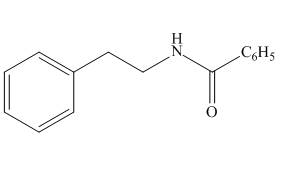
Explanation of Solution
The product formed by the reaction of given amine compound with an anhydride is shown as,

Figure 6
In the given reaction, amine group of the reactant reacts with the anhydride to form a desired amide product. This amide product is a secondary amide.
The product of the given reaction is shown in Figure 6.
(g)
Interpretation: The organic product that is formed in the given reaction is to be determined.
Concept introduction: The various organic reactions form different organic products with the help of the variety of reagents. Some of the organic compounds are formed by the characteristic action of the various functional groups present in them.
Answer to Problem 25.65P
The product of the given reaction is,
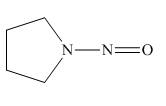
Explanation of Solution
The product formed by the reaction of given cyclic secondary amine with sodium nitrite in the presence of an acid is shown as,

Figure 7
In the given reaction, amine group of the reactant reacts with
The product of the given reaction is shown in Figure 7.
(h)
Interpretation: The organic product that is formed in the given reaction is to be determined.
Concept introduction: The various organic reactions form different organic products with the help of the variety of reagents. Some of the organic compounds are formed by the characteristic action of the various functional groups present in them.
Answer to Problem 25.65P
The product of the given reaction is,
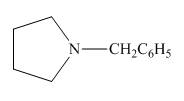
Explanation of Solution
The product formed by the reaction of given cyclic secondary amine with an

Figure 8
In the given reaction, amine group of the reactant reacts with benzaldehyde in the presence of
The product of the given reaction is shown in Figure 8.
(i)
Interpretation: The organic product that is formed in the given reaction is to be determined.
Concept introduction: The various organic reactions form different organic products with the help of the variety of reagents. Some of the organic compounds are formed by the characteristic action of the various functional groups present in them.
Answer to Problem 25.65P
The product of the given reaction is,
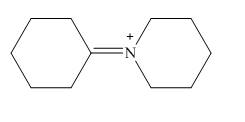
Explanation of Solution
The product formed by the reaction of given cyclic amine compound with an cyclic

Figure 9
In the given reaction, amine group of the reactant reacts with a cyclic ketonic compound to form a desired product.
The product of the given reaction is shown in Figure 9.
(j)
Interpretation: The organic product that is formed in the given reaction is to be determined.
Concept introduction: The various organic reactions form different organic products with the help of the variety of reagents. Some of the organic compounds are formed by the characteristic action of the various functional groups present in them.
Answer to Problem 25.65P
The product of the given reaction is
Explanation of Solution
The product formed by the reaction of given secondary amine compound with methyl iodide in the presence of

Figure 10
In the given reaction, amine group of the reactant reacts with
The product of the given reaction is
Want to see more full solutions like this?
Chapter 25 Solutions
Organic Chemistry-Package(Custom)
- A student proposes the transformation below in one step of an organic synthesis. There may be one or more reactants missing from the left-hand side, but there are no products missing from the right-hand side. There may also be catalysts, small inorganic reagents, and other important reaction conditions missing from the arrow. • Is the student's transformation possible? If not, check the box under the drawing area. . If the student's transformation is possible, then complete the reaction by adding any missing reactants to the left-hand side, and adding required catalysts, inorganic reagents, or other important reaction conditions above and below the arrow. • You do not need to balance the reaction, but be sure every important organic reactant or product is shown. + T X O O лет-ле HO OH HO OH This transformation can't be done in one step.arrow_forwardDetermine the structures of the missing organic molecules in the following reaction: X+H₂O H* H+ Y OH OH Note: Molecules that share the same letter have the exact same structure. In the drawing area below, draw the skeletal ("line") structures of the missing organic molecules X and Y. You may draw the structures in any arrangement that you like, so long as they aren't touching. Click and drag to start drawing a structure. X Sarrow_forwardPredict the major products of this organic reaction. If there aren't any products, because nothing will happen, check the box under the drawing area instead. No reaction. HO. O :☐ + G Na O.H Click and drag to start drawing a structure. XS xs H₂Oarrow_forward
- What are the angles a and b in the actual molecule of which this is a Lewis structure? H H C H- a -H b H Note for advanced students: give the ideal angles, and don't worry about small differences from the ideal groups may have slightly different sizes. a = b = 0 °arrow_forwardWhat are the angles a and b in the actual molecule of which this is a Lewis structure? :0: HCOH a Note for advanced students: give the ideal angles, and don't worry about small differences from the ideal that might be caused by the fact that different electron groups may have slightly different sizes. a = 0 b=0° Sarrow_forwardDetermine the structures of the missing organic molecules in the following reaction: + H₂O +H OH O OH +H OH X Note: Molecules that share the same letter have the exact same structure. In the drawing area below, draw the skeletal ("line") structure of the missing organic molecule X. Click and drag to start drawing a structure.arrow_forward
- Identify the missing organic reactant in the following reaction: x + x O OH H* + ☑- X H+ O O Х Note: This chemical equation only focuses on the important organic molecules in the reaction. Additional inorganic or small-molecule reactants or products (like H₂O) are not shown. In the drawing area below, draw the skeletal ("line") structure of the missing organic reactant X. Click and drag to start drawing a structure. Carrow_forwardCH3O OH OH O hemiacetal O acetal O neither O 0 O hemiacetal acetal neither OH hemiacetal O acetal O neither CH2 O-CH2-CH3 CH3-C-OH O hemiacetal O acetal CH3-CH2-CH2-0-c-O-CH2-CH2-CH3 O neither HO-CH2 ? 000 Ar Barrow_forwardWhat would be the best choices for the missing reagents 1 and 3 in this synthesis? 1. PPh3 2 2. n-BuLi 3 Draw the missing reagents in the drawing area below. You can draw them in any arrangement you like. • Do not draw the missing reagent 2. If you draw 1 correctly, we'll know what it is. • Note: if one of your reagents needs to contain a halogen, use bromine. Explanation Check Click and drag to start drawing a structure.arrow_forward
- Predict the products of this organic reaction: NaBH3CN + NH2 ? H+ Click and drag to start drawing a structure. ×arrow_forwardPredict the organic products that form in the reaction below: + OH +H H+ ➤ ☑ X - Y Note: You may assume you have an excess of either reactant if the reaction requires more than one of those molecules to form the products. In the drawing area below, draw the skeletal ("line") structures of the missing organic products X and Y. You may draw the structures in any arrangement that you like, so long as they aren't touching. Click and drag to start drawing a structure. Garrow_forwardPredict the organic products that form in the reaction below: OH H+ H+ + ☑ Y Note: You may assume you have an excess of either reactant if the reaction requires more than one of those molecules to form the products. In the drawing area below, draw the skeletal ("line") structures of the missing organic products X and Y. You may draw the structures in any arrangement that you like, so long as they aren't touching. Click and drag to start drawing a structure. ✓ marrow_forward
 ChemistryChemistryISBN:9781305957404Author:Steven S. Zumdahl, Susan A. Zumdahl, Donald J. DeCostePublisher:Cengage Learning
ChemistryChemistryISBN:9781305957404Author:Steven S. Zumdahl, Susan A. Zumdahl, Donald J. DeCostePublisher:Cengage Learning ChemistryChemistryISBN:9781259911156Author:Raymond Chang Dr., Jason Overby ProfessorPublisher:McGraw-Hill Education
ChemistryChemistryISBN:9781259911156Author:Raymond Chang Dr., Jason Overby ProfessorPublisher:McGraw-Hill Education Principles of Instrumental AnalysisChemistryISBN:9781305577213Author:Douglas A. Skoog, F. James Holler, Stanley R. CrouchPublisher:Cengage Learning
Principles of Instrumental AnalysisChemistryISBN:9781305577213Author:Douglas A. Skoog, F. James Holler, Stanley R. CrouchPublisher:Cengage Learning Organic ChemistryChemistryISBN:9780078021558Author:Janice Gorzynski Smith Dr.Publisher:McGraw-Hill Education
Organic ChemistryChemistryISBN:9780078021558Author:Janice Gorzynski Smith Dr.Publisher:McGraw-Hill Education Chemistry: Principles and ReactionsChemistryISBN:9781305079373Author:William L. Masterton, Cecile N. HurleyPublisher:Cengage Learning
Chemistry: Principles and ReactionsChemistryISBN:9781305079373Author:William L. Masterton, Cecile N. HurleyPublisher:Cengage Learning Elementary Principles of Chemical Processes, Bind...ChemistryISBN:9781118431221Author:Richard M. Felder, Ronald W. Rousseau, Lisa G. BullardPublisher:WILEY
Elementary Principles of Chemical Processes, Bind...ChemistryISBN:9781118431221Author:Richard M. Felder, Ronald W. Rousseau, Lisa G. BullardPublisher:WILEY





